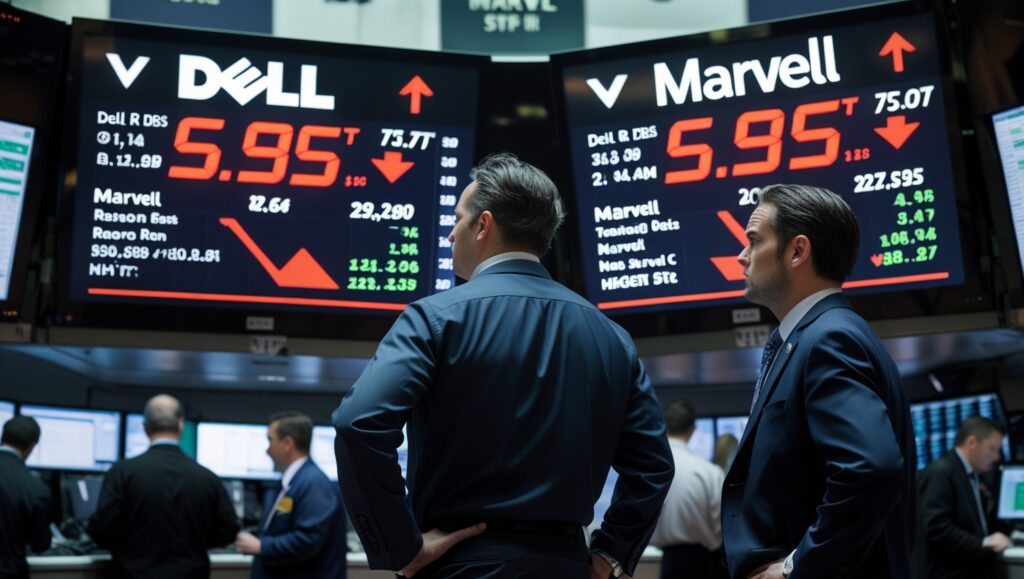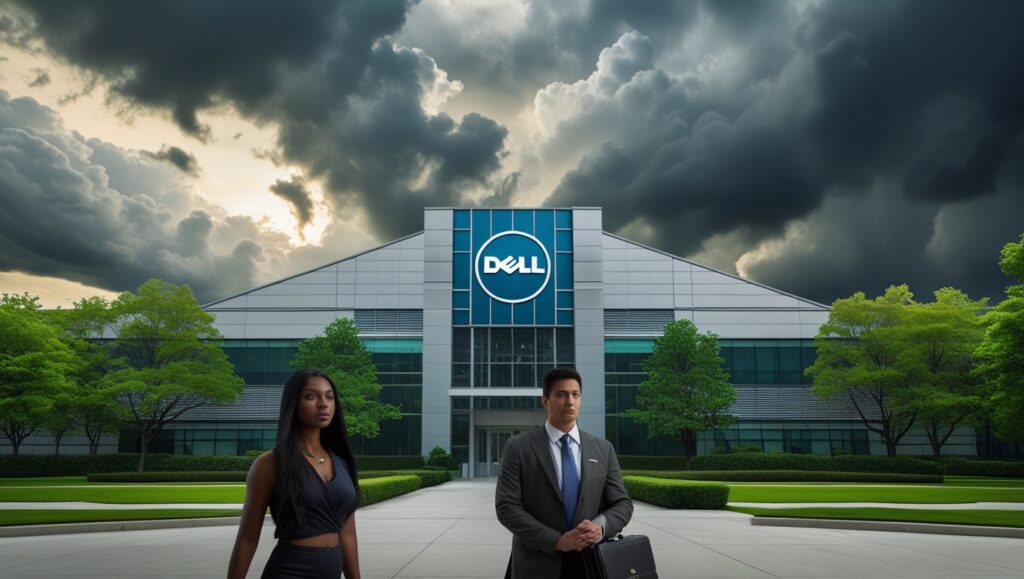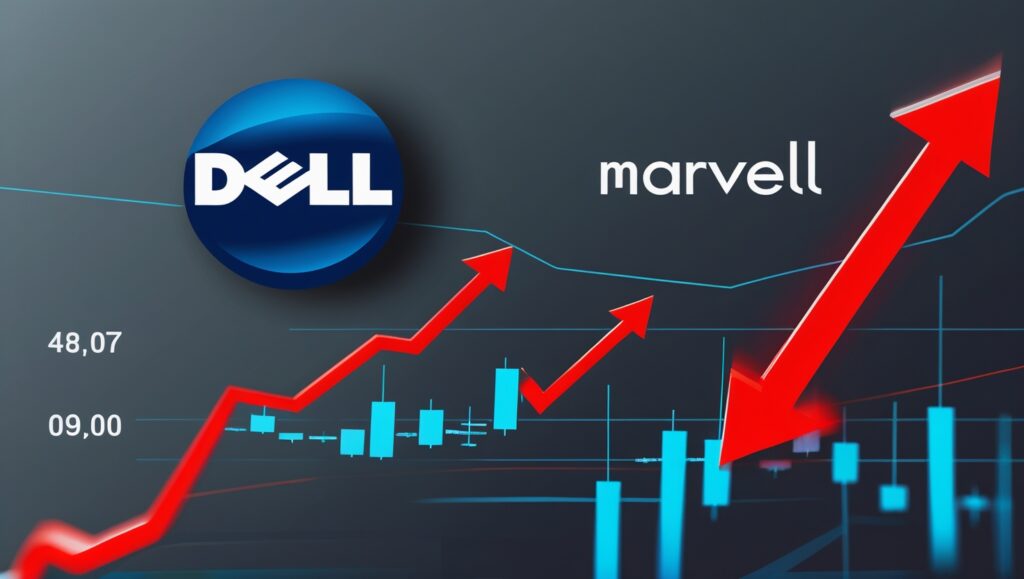Physical Address
304 North Cardinal St.
Dorchester Center, MA 02124
Physical Address
304 North Cardinal St.
Dorchester Center, MA 02124

Two computer companies, Dell Technologies and Marvell Technologies, became the focus of investor angst during a week filled with economic conjecture and quarterly results. More than merely a decline in share prices was indicated by the headline “Dell and Marvell stocks slide,” which swiftly spread throughout the financial media. For the tech industry, it was a time of reckoning when lofty ideals were met with harsh realities. The market reacted with quick and dramatic corrections as Wall Street processed the most recent quarterly reports, leaving analysts and investors frantically trying to figure out what went wrong and what to do next.

The term “sliding Dell and Marvell stocks” refers to a notable decline in the share prices of both companies after their earnings reports were made public. Following the release of a dismal third-quarter earnings prediction, Dell Technologies’ stock dropped by almost 6% in premarket trade. Investors were alarmed by the company’s margin outlook and cautious guidance, even if revenue and adjusted profits projections were exceeded. In contrast, Marvell Technology’s stock fell more than 13% when the chipmaker’s data center demand forecast fell short of the extremely high expectations.
This decline is about sentiment as much as numbers. Due to their extensive integration into the tech ecosystem, both businesses’ performance is sometimes seen as a predictor of more general trends in semiconductor innovation and enterprise computing. The market is affected when Dell and Marvell’s stocks decline, leading to reevaluations of risk, valuation, and growth potential.
One of the mainstays of the business hardware industry for a long time is Dell Technologies. Dell has developed into a multifaceted IT giant, offering everything from personal PCs to servers and storage solutions. Bold decisions throughout its history include going private in 2013 and reentering public markets in 2018. Dell has established itself as a pioneer in cloud computing, AI-driven computing, and digital transformation over the years.
In contrast, Marvell Technology has established a distinct market niche in the semiconductor industry. Marvell, which is well-known for its high-performance semiconductors used in networking, storage, and data centers, has capitalized on the demand for AI and cloud computing. The company has become a major player in the competition to power next-generation digital infrastructure as a result of its recent concentration on custom silicon for hyperscale clients like Microsoft and Amazon.
Both businesses have profited from the last ten years’ tech boom, but they have also had to deal with issues including changing consumer behavior and supply chain interruptions. Investors have been reminded that even sector leaders are susceptible to volatility by the most recent earnings season, which has placed such difficulties into stark focus.

The decline in Dell and Marvell stocks is more than a temporary setback—it’s a signal that the market is recalibrating its expectations. For Dell, the issue lies in its margin compression and cautious outlook, which suggest that demand for corporate PCs and storage solutions may be softening. Even with strong AI server shipments, the company’s broader business segments are under pressure.
Marvell’s slide is tied to its inability to deliver upside surprises in a market hungry for AI-driven growth. Despite reporting record revenue of $2 billion, the company failed to meet the lofty expectations set by analysts and investors. The result was a swift correction, as traders reassessed the sustainability of Marvell’s growth trajectory.
These developments matter because they influence portfolio strategies, sector rotation, and risk appetite. When Dell and Marvell stocks slide, it forces investors to reconsider their exposure to tech and to differentiate between hype and fundamentals.
When earnings reports are released, the market frequently responds quickly and harshly. On the upside, they bring clarity. Investors are given a real-time picture of how businesses are doing and how the market is responding to their initiatives. Making well-informed decisions and preserving a robust investment environment depend on this transparency.
The drawback is that emotions may be overblown. Even if the long-term picture is unaffected, a single quarter of poor forecast can lead to significant selloffs. Both fund managers and individual investors may find this volatility problematic, particularly in industries like technology where emotion is very important.
The slip might be temporary in the Dell and Marvell scenario. Both businesses are well-positioned to profit from long-term trends in cloud computing, artificial intelligence, and enterprise transformation, and they have solid foundations. However, the instant effect serves as a warning that expectations drive markets, and when those expectations aren’t fulfilled, there may be quick repercussions.

Beyond Wall Street, the drop in Dell and Marvell’s shares has practical ramifications. Employee pay and morale may be impacted, particularly if stock-based incentives are a component of their compensation plan. It can indicate changes in price or product strategy for consumers. Additionally, it gives rivals the opportunity to increase their market share or rebrand as more reliable options.
The volatility of tech stocks can affect innovation cycles, capital investment, and consumer confidence in the larger economy. It raises concerns about the state of the industry and the viability of current growth trends when big firms like Dell and Marvell falter.
Why did Dell’s stock fall even though its earnings were better than expected?
Due to investors’ disappointment with Dell’s third-quarter earnings prediction, the company’s shares plummeted. A selloff resulted from worries about margin compression and lower-than-expected projections, even though revenue and adjusted earnings exceeded expectations2.
What led to the decline in Marvell’s stock?
After Marvell’s data center demand forecast failed to meet expectations, the company’s stock plunged precipitously. The market was searching for more robust indications of AI-driven growth, especially in the face of record revenue.
Is this slide a persistent issue?
Not always. Both businesses are well-positioned in their respective areas and have solid foundations. The slide, however, conveys a sense of immediacy and the need for more precise growth tales.
How should investors respond?
Investors should assess their exposure to tech and consider whether their portfolios align with long-term trends. Diversification and a focus on fundamentals can help mitigate volatility.
Are other tech stocks affected?
Yes, the slide in Dell and Marvell stocks has contributed to broader weakness in the tech sector, especially among companies tied to AI and enterprise infrastructure.
A potent reminder of how swiftly market opinion can change is the recent decline in Dell and Marvell stocks. Both businesses saw significant corrections as a result of cautious guidance and unfulfilled expectations, despite their impressive earnings and attractive long-term objectives. This instance emphasizes to investors the value of remaining informed, controlling risk, and seeing past the news.
The performance of businesses like Dell and Marvell will be constantly monitored as the tech industry develops further. Whether this decline is a short-term setback or an indication of more serious difficulties will depend on their capacity to adjust, innovate, and provide consistent outcomes. Meanwhile, the term “Dell and Marvell stocks slide” will be used as a case study on investor behavior, market psychology, and the dynamically shifting nature of the digital economy.
Pay attention to these two names if you’re following tech trends or developing a portfolio. Their experience with instability might present both unanticipated possibilities and important lessons.